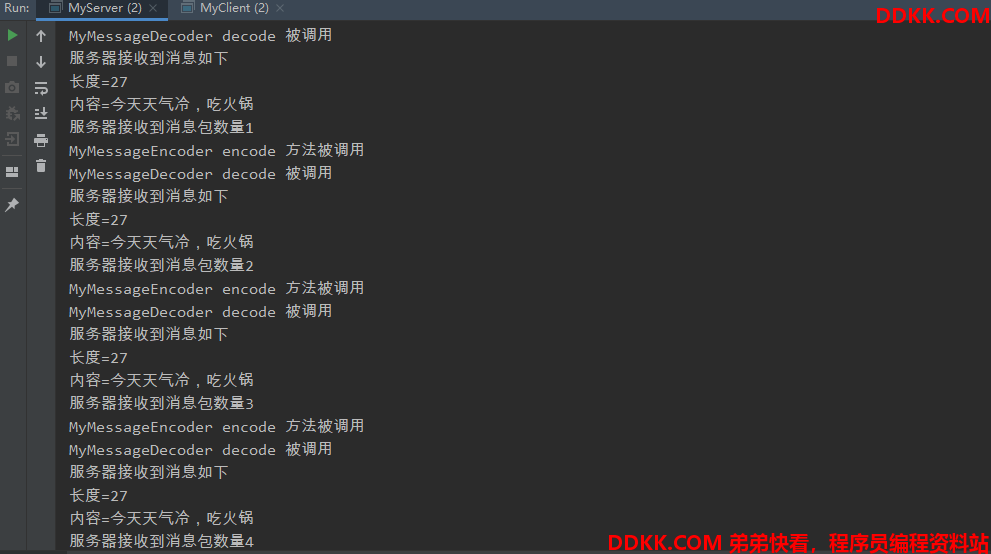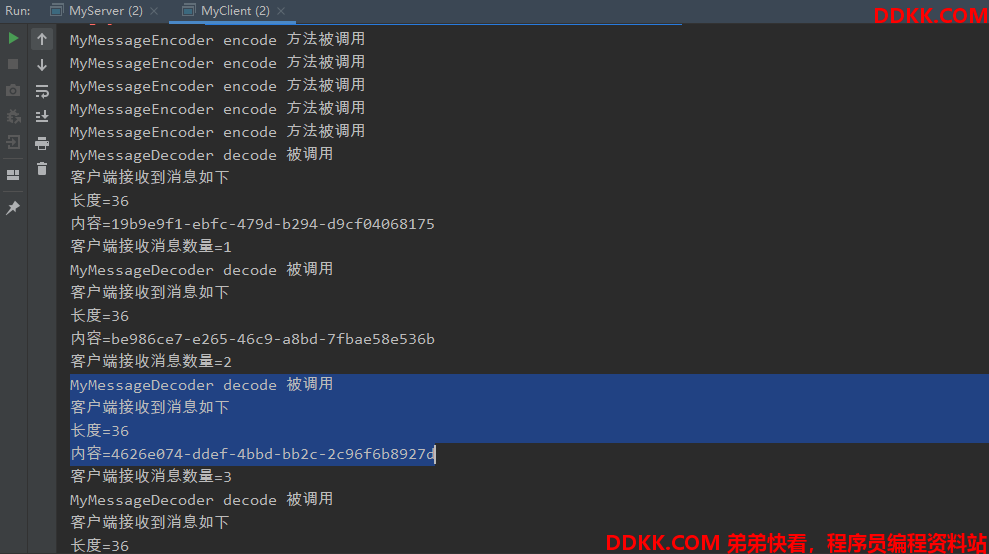一、解决方案
1、使用 自定义协议 + 编解码器 来解决
2、关键就是要解决 服务器端每次读取数据长度的问题,这个问题解决,就不会出现服务器多读或少读数据的问题,从而避免了 TCP粘包和拆包
二、应用实例
1、要求客户端发送 5 个 Message 对象,客户端每次发送一个 Message 对象
2、服务器端每次接收一个Message,分 5 次进行解码,每读取到一个Message,会回复一个Message对象给客户端

2.1 协议包
public class MessageProtocol {
private int len; // 关键
private byte[] content;
public int getLen() {
return len;
}
public void setLen(int len) {
this.len = len;
}
public byte[] getContent() {
return content;
}
public void setContent(byte[] content) {
this.content = content;
}
}
2.2 编解码器
编码器:
public class MyMessageEncoder extends MessageToByteEncoder<MessageProtocol> {
@Override
protected void encode(ChannelHandlerContext ctx, MessageProtocol msg, ByteBuf out) throws Exception {
System.out.println("MyMessageEncoder encode 方法被调用");
out.writeInt(msg.getLen());
out.writeBytes(msg.getContent());
}
}
解码器:
public class MyMessageDecoder extends ReplayingDecoder<Void> {
@Override
protected void decode(ChannelHandlerContext ctx, ByteBuf in, List<Object> out) throws Exception {
System.out.println("MyMessageDecoder decode 被调用");
// 需要将得到的 二进制字节码 转换成 MessageProtocol 协议包(对象)
int length = in.readInt();
byte[] content = new byte[length];
in.readBytes(content);
// 封装成 MessageProtocol 对象,放到 out 中,传递给下一个handler进行业务处理
MessageProtocol messageProtocol = new MessageProtocol();
messageProtocol.setLen(length);
messageProtocol.setContent(content);
out.add(messageProtocol);
}
}
2.3 客户端
客户端启动类:
public class MyClient {
public static void main(String[] args) throws InterruptedException {
EventLoopGroup group = new NioEventLoopGroup();
try {
Bootstrap bootstrap = new Bootstrap();
bootstrap.group(group)
.channel(NioSocketChannel.class)
.handler(new MyClientInitializer()); // 自定义一个初始化类
ChannelFuture future = bootstrap.connect("127.0.0.1", 7000).sync();
future.channel().closeFuture().sync();
}finally {
group.shutdownGracefully();
}
}
}
客户端初始化类:
public class MyClientInitializer extends ChannelInitializer<SocketChannel> {
@Override
protected void initChannel(SocketChannel ch) throws Exception {
ChannelPipeline pipeline = ch.pipeline();
pipeline.addLast(new MyMessageEncoder()); // 编码器
pipeline.addLast(new MyMessageDecoder()); // 解码器
pipeline.addLast(new MyClientHandler());
}
}
客户端处理器:
public class MyClientHandler extends SimpleChannelInboundHandler<MessageProtocol> {
private int count;
@Override
public void channelActive(ChannelHandlerContext ctx) throws Exception {
// 使用客户端发送10条数据:今天天气冷,吃火锅 编号
for (int i = 0; i < 5; i++) {
String msg = "今天天气冷,吃火锅";
byte[] content = msg.getBytes(Charset.forName("utf-8"));
int length = content.length;
// 创建协议包对象
MessageProtocol messageProtocol = new MessageProtocol();
messageProtocol.setContent(content);
messageProtocol.setLen(length);
ctx.writeAndFlush(messageProtocol);
}
}
@Override
protected void channelRead0(ChannelHandlerContext ctx, MessageProtocol msg) throws Exception {
int len = msg.getLen();
byte[] content = msg.getContent();
System.out.println("客户端接收到消息如下");
System.out.println("长度=" + len);
System.out.println("内容=" + new String(content, Charset.forName("utf-8")));
System.out.println("客户端接收消息数量=" + (++this.count));
}
@Override
public void exceptionCaught(ChannelHandlerContext ctx, Throwable cause) throws Exception {
System.out.println("异常消息=" + cause.getMessage());
ctx.close();
}
}
2.4 服务器端
服务器端启动类:
public class MyServer {
public static void main(String[] args) throws InterruptedException {
EventLoopGroup bossGroup = new NioEventLoopGroup(1);
EventLoopGroup workerGroup = new NioEventLoopGroup();
try {
ServerBootstrap bootstrap = new ServerBootstrap();
bootstrap.group(bossGroup,workerGroup)
.channel(NioServerSocketChannel.class)
.childHandler(new MyServerInitializer()); // 自定义一个初始化类
ChannelFuture future = bootstrap.bind(7000).sync();
future.channel().closeFuture().sync();
}finally {
bossGroup.shutdownGracefully();
workerGroup.shutdownGracefully();
}
}
}
服务器端初始化类:
public class MyServerInitializer extends ChannelInitializer<SocketChannel> {
@Override
protected void initChannel(SocketChannel ch) throws Exception {
ChannelPipeline pipeline = ch.pipeline();
pipeline.addLast(new MyMessageDecoder());// 解码器
pipeline.addLast(new MyMessageEncoder());// 编码器
pipeline.addLast(new MyServerHandler());
}
}
服务器端处理器:
public class MyServerHandler extends SimpleChannelInboundHandler<MessageProtocol> {
private int count;
@Override
protected void channelRead0(ChannelHandlerContext ctx, MessageProtocol msg) throws Exception {
// 接收到数据,并处理
int len = msg.getLen();
byte[] content = msg.getContent();
System.out.println("服务器接收到消息如下");
System.out.println("长度=" + len);
System.out.println("内容=" + new String(content, Charset.forName("utf-8")));
System.out.println("服务器接收到消息包数量" + (++this.count));
// 回复消息
String resContent = UUID.randomUUID().toString();
byte[] resContentBytes = resContent.getBytes(Charset.forName("utf-8"));
int resLength = resContentBytes.length;
// 构建协议包
MessageProtocol messageProtocol = new MessageProtocol();
messageProtocol.setLen(resLength);
messageProtocol.setContent(resContentBytes);
ctx.writeAndFlush(messageProtocol);
}
@Override
public void exceptionCaught(ChannelHandlerContext ctx, Throwable cause) throws Exception {
System.out.println("异常消息=" + cause.getMessage());
ctx.close();
}
}
2.5 效果演示

